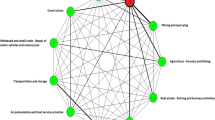Abstract
It is not unusual for the level of a monthly economic time series, such as industrial production, retail and wholesale sales, monetary aggregates, telephone calls or road accidents, to be influenced by calendar effects. Such effects arise when changes occur in the level of activity resulting from differences in the composition of calendar between years. The two main sources of calendar effects are trading day variations and moving festivals. Ignoring such calendar effects will lead to substantial distortions in the identification stage of time series modeling. Therefore, it is mandatory to introduce calendar effects, when they are present in a time series, as the component of the model which one wants to estimate.
Similar content being viewed by others
Reference
Ashley, R., “On the relative worth of recent macroeconomic forecasts”, International Journal of Forecasting, Vol. 4, pp363–376, 1988.
Bell. W.R., S.C. Hillmer, “Modeling time series with calendar variation”, Journal of the American Statistical Society, Vol. 78, pp526–534, 1983.
Box, G.E.P., G.M. Jenkins, Time Series Analysis: Forecasting and Control, San Francisco: Holden-Day, 1976.
Burman, P., “Seasonal adjustment by signal extraction”, Journal of the Royal Staistical Society, A, Vol. 143, pp 321–347, 1980.
Cleveland, W.S., S.J. Devlin, “Calendar effects in monthly time series. Detection by spectral analysis and graphical methods”. Journal of the American Statistical Association, Vol. 75, pp 487–496, 1980.
Cleveland, W.P., M.R. Grupe, “Modeling time series when calendar effexts are present”, in A. Zellner (ed.), Proceedings of the Conference on Applied Time Series Analysis of Economic Data, U.S. Department of Commerce, Bureau of the Census, Washington, pp57–67, 1981.
Harvey, A.C., Forecasting, Structural Time Series Models and the Kalman Filter, Cambridge: Cambride University Press, 1989.
Hillmer, S.C., “Forecasting time series with trading day variation,” Journal of Forecasting, Vol. 1, pp385–395, 1982.
Hillmer, S.C., G.C. Tiao, “An ARIMA-model based approach to seasonal adjustment”, Journal of the American Statistical Association, Vol. 77, pp63–70, 1982.
Hillmer, S.C., W.R. Bell, G.C. Tiao, “Modeling considerations in the seasonal adjustment of economic time series”, in A. Zellner (ed.), Proceedings of the Conference on Applied Time Series Analysis of Economic Data, U.S. Department of Commerce, Bureau of the Census, Washington, pp74–100, 1981.
Koopman, S.J., A.C. Harvey, J.A. Dornik, N. Shephard, Structural Time Series Analysis, Modelling and Prediction using STAMP, 2nd edition, London, Timberlake Consultants Press, 1999.
Liu L.-M., “Identification of time series models in the presence of calendar variation”, International Journal of Forecasting, Vol. 2, pp 357–372, 1986.
Liu, L.-M., “Analysis of time series with calendar effects”, Management Science, Vol. 26, pp106–112, 1980.
Liu, L.-M., D.M. Hanssens, “Identification of multiple-input transfer function models”, Communications in Statistics A, Vol. 11, pp297–314, 1982.
Liu, L.-M., G.B. Hudak in colloboration with G.E.P. Box, M.E. Muller, G.C. Tiao, Forecasting and Time Series Analysis Using the SCA Statistical System, Vol. 1, Scientific Computing Associates Corp., Oak Brook, Illinois, USA, 1994.
Maravall, A., “The use of ARIMA models in unobserved components estimation”, in Barnett, W., E. Berndt, H. White (eds.), Dynamic Econometric Modeling, Cambridge, Cambridge University Press, 1988.
Nelson, C.R. “The prediction performance of the F.R.B.-M.I.T.-PENN model of the U.S. economy”, American Economic Review, Vol. 62, pp902–917, 1972
RATS, Version 5.11, Estima, Evanstone, Illinois, USA, 2003.
Salinas, T.S., S.C. Hillmer, “Multicollinearity probelms in modeling time series models with trading-day variation”, Journal of Business and Economic Statistics, Vol. 5, pp431–436, 1987a.
Salinas, T.S., S.C. Hillmer, “Time series model identification in the presence of trading day variation”, American Statistical Association, Proceedings of the Business and Economic Statistics Section, pp431–436, 1987b.
SCA Statistical System, Release VI.2, Scientific Computing Associates Corp., Illinois, USA, 1999.
Thury, G., “Industrial production in Germany and Austria: a case study in structural time series modelling”, Journal of Systems Science and Systems Engineering, 12, Vol. 12, No. 2, pp159–170, 2003.
Tsay, R.S., “Regression models with time series errors”, Journal of the American Statistical Association, Vol. 78, pp118–124, 1984.
Wei, W.W.S., Time Series Analysis. Univariate and Multivariate Methods, Addison-Wesley Publishing Company, 1994.
Author information
Authors and Affiliations
Additional information
Gerhard Thury Start of studies in 1959 at the University of Economics in Vienna, Austria. In 1964, he received the doctoral degree. From 1964 to 1996, post-graduate studies in economics and econometrics at the Institute of Advanced Studies in Vienna. From 1966 till 1996, he was the member of the scientific staff of the Austrian Institute of Economic Research in Vienna. Main field of research there was applied econometrics specializing on forecasting, econometric model building and policy simulation, time series analysis and seasonal adjustment. Publication of numerous articles in international and Austrian journals. Participation and presentation of papers at international conferences. Visiting scholar at the London Business School, Great Britain, in 1975 and at the University of Illinois in Urbana-Champaign, USA, in 1981 for half a year, respectively. In 1996, retirement from the Austrian Institute of Research. Since then, several visits to China presenting courses on recent developments in econometrics and time series analysis.
Mi Zhou Began to study in Beihang with the major in International Finance in 1997. Continued to do doctoral research on Management Science and Engineering after graduation of BUAA in 2001 till now with the research on Knowledge Management and Data Mining.
Rights and permissions
About this article
Cite this article
Thury, G., Zhou, M. Calendar effects in monthly time series models. J. Syst. Sci. Syst. Eng. 14, 218–230 (2005). https://doi.org/10.1007/s11518-006-0191-x
Issue Date:
DOI: https://doi.org/10.1007/s11518-006-0191-x




